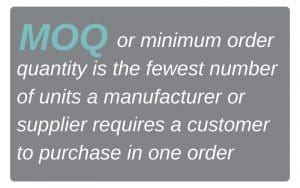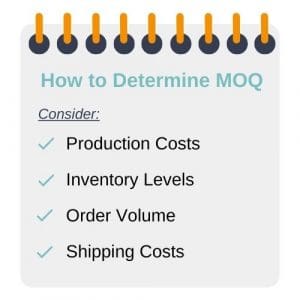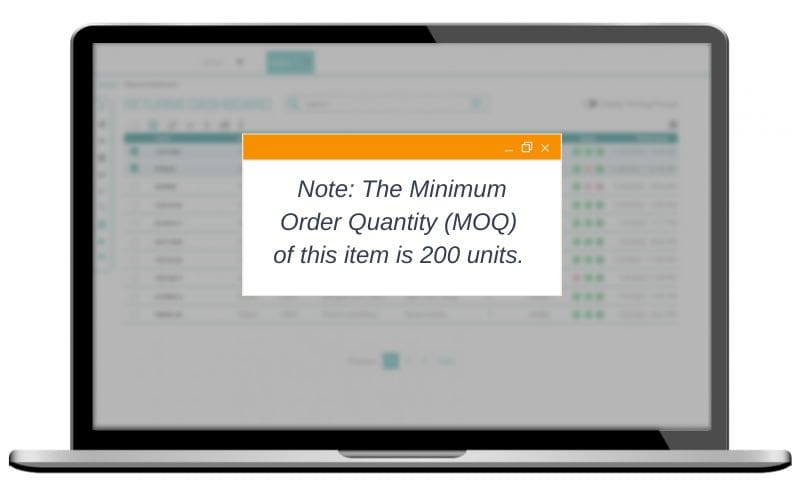
Regardless of whether you run a B2B or a B2C eCommerce business, you probably prefer large orders compared to small ones. That’s where minimum order quantity or MOQ comes into play. MOQ helps ensure that orders are cost-effective, profitable, and include a consistent gross margin. It also helps ensure you have enough inventory to meet demand, instead of too much that you have to hold onto the stock you can’t sell. So what is MOQ (minimum order quantity)?
This post will look at everything you need to know about this concept, including what it is, how to determine it, and how to manage it in the last mile.
What is MOQ?

MOQ or minimum order quantity (also known as minimum order size) is the fewest number of units a manufacturer or supplier requires a customer to purchase in one order. Manufacturers/suppliers set minimum order quantities to avoid wasting resources on orders that deliver little or no profit.
This concept can either be simple or complex depending on the product being purchased and the economic considerations related to the order. Simple MOQ refers to the set quantity of a product that a customer must purchase from a supplier without any additional criteria. For instance, suppose a supplier’s MOQ is 1500 units; it means you can buy no less than 1500 units of the inventory at a time. On the other hand, complex MOQ requires that a customer meets a specific condition (say, minimum weight/volume, dollar value, or time-based requirements) in addition to the agreed-upon quantity. For example, a supplier may mandate that customers purchase at least 500 units of their product at a minimum value of $5,000 over one month.
That said, minimum order quantity is often confused with minimum order value (MOV). However, they aren’t the same. While MOQ is the fewest number of units a business wants to sell to a customer at one time, MOV is the minimum amount that a business requires customers to spend on its products per order. If a business sets the MOV at $500, it won’t accept an order whose value is below that amount.
Should You Enforce MOQ?
For suppliers and manufacturers, MOQ can have several significant benefits. When managed properly, it can be a crucial tool for managing inventory and keeping profit margins high. Customers can also benefit in terms of economies of scale and improved supplier relationships.
Here’s a close look at how MOQ can affect various aspects of your eCommerce business:
Pricing and Profitability
An extensively researched and well-calculated MOQ can help increase your profit margins. This is because it gives you better control of your profit margins. Additionally, the large order volumes that come with enforcing minimum order quantity encourage economies of scale, which means lower cost per unit as production increases.
When setting MOQ, ensure you price your products such that you get the highest profit margins. For instance, if you set a low value, it’s necessary to set a high unit price to compensate for the lower total profit on your orders. On the other hand, if you set a high value, you may need to price your products low to encourage customers to purchase them.
Logistics and Delivery Process
How MOQ will affect your logistics and delivery process will depend on whether it is low or high. When you have a high MOQ, you’ll need a significant amount of inventory to fulfill orders. Larger inventory requirements not only take up a lot of warehouse space but also ties up a significant amount of working capital. However, it helps improve the efficiency o your logistics and delivery process since you’ll be able to make large deliveries between long intervals rather than making small deliveries frequently.
Suppose you have a low MOQ; it means that you’ll need to make smaller deliveries more frequently. This will lead to you spending more money to fulfill customers and deliveries.
Customer Experience
MOQ can help you improve customer experience in a number of ways. For instance, by offering customers lower prices or discounts on larger orders, they can save on costs. Customers can also better manage their inventory levels and minimize reordering frequency by purchasing large quantities at one time. Additionally, communicating this value helps build trust with customers. This leads to better relationships based on respect and mutual understanding.
Cash Flow
Cash flow refers to how money flows in and out of a business. When a business has a healthy cash flow, it will always have enough money to cover operational costs such as warehousing and labor. A well-researched and managed minimum order quantity can help suppliers have a healthier and more predictable cash flow.
Inventory Management
Your MOQ will have a major impact on your inventory. It will affect the number of days you hold stock, how frequently you get orders, how you deliver products to customers, and the space available in your warehouse. When you have a well-researched minimum order quantity, you’ll be better positioned to manage your inventory more efficiently by keeping your stock levels stable and minimizing the risks of stockouts or overstocking.
Factors to Consider When Determining MOQ

If you do decide to enforce a minimum order quantity, consider the following factors: production costs, inventory levels, order volume, and shipping costs.
Production Costs
As a manufacturer or supplier, you need to factor in your production cost when determining MOQ. Remember, MOQ is primarily about offering discounts or lower prices in exchange for large purchases. This means that failing to factor in your production costs may result in you making losses, despite the increase in sales. As a rule of thumb, you should ensure that your price per unit is higher than your production cost per unit.
Inventory Levels
The type of minimum order quantity strategy you enforce should be influenced by the inventory you have. For instance, if you want to implement a high minimum order quantity (high MOQ), you’ll need to keep a significant amount of inventory on hand to fulfill orders efficiently. This is because you’ll likely see a higher average order size. Conversely, if you want to implement a low minimum order quantity (low MOQ), you won’t need as much inventory on hand for fulfilling orders. This could mean less inventory with higher inventory turnover.
Order Volume
As a supplier, you must determine the break-even for when an order will start generating profits. One way of achieving this feat is to consider who you’re currently selling to and who you’ll likely sell to going forward. For instance, if you currently sell to small traders, your MOQ should be lower than if your primary customers are big-box retail chains.
You’ll also need to adjust your pricing accordingly. Suppose you sell high-volume or low-margin products, you may need a high MOQ to break even.
Shipping Costs
You also need to consider the shipping cost when determining your MOQ. This is especially the case if you use a shipping company to deliver customer orders.
Generally, most shipping companies charge shipping costs based on the weight of a package and the distance to the delivery location. Regardless of whether you opt to enforce low MOQ or high MOQ, you should ensure that you factor in the shipping costs. Remember, low MOQ may eat into your profit since you will need to frequently ship orders to customers. Similarly, high MOQ attracts high shipping costs, given the often heavier weight of the load.
Another factor you should consider is demand. Look at your historical data and forecast demand. Suppose you previously received orders for around 1000 units, suddenly implementing an MOQ of 500 units may not be feasible. Other factors to consider are things like lead times and seasonality.
After you’ve gathered all the data, set the minimum order quantity for each product and develop a strategy for implementing it successfully. If necessary, use incentives such as bulk-buying discounts. This will help improve your inventory management and bottom line.
Steps for Implementing an MOQ

If you want to implement an MOQ on some or all of your existing customers or even if you are a supplier just getting started, it’s vital to be deliberate with the process. The implementation of an MOQ takes more than just announcing the change or deciding on an MOQ that would be perfect for your business, it requires you to take the market conditions into account. Here are the three steps for successfully implementing an MOQ:
- Calculate the Target MOQ Carefully: Start by determining the appropriate MOQ for each product. During your calculation, ensure that you consider factors such as production costs, shipping costs, inventory levels, and order volume. You may also factor in demand and seasonality into your calculation.
- Inform Existing Customers: Suppose it’s your first time implementing an MOQ and you already have existing customers, inform them of your intention well in advance—even if they often meet the MOQ. Explain to them why you’re implementing the MOQ. Also, try to find ways to work with customers who don’t usually order enough to meet the MOQ. It’s important to keep in mind that implementing an MOQ might result in you losing some customers.
- Enforce the MOQ: The MOQ will only work if you enforce it. A good place to start would be to inform your account managers and sales representatives of the MOQ early, so they understand how it works at what resources are available to them.
How Different Industries Use MOQs
Different industries implement MOQs differently. Here’s a look at home some major industries use MOQs.
Fashion and Design Industry
MOQ is typically used in the fashion and design industry to determine the minimum number of items that a manufacturer will accept for a production order. For instance, if a clothing manufacturer offers an MOQ of 100 pieces per style, then you will need to order at least 100 pieces of that particular style to meet the supplier’s requirements for a single production run. Each clothing manufacturer will define MOQ differently. Some will base their MOQ on the total order size of an item, regardless of size or color, while others may set the MOQ based on color, size, and other variables.
Whereas designers and buyers have restricted budgets and quantity requirements, clothing manufacturers ensure that each job they take on is big enough for them to make sufficient profits.
Automotive Industry
Generally, most car manufacturers sell cars in bulk. As such, this industry is well-suited for MOQ application. And since cars are bulky, most manufacturers often apply low MOA. MOA can also be used in the automotive industry when buying car parts.
Watchmaking Industry
Watchmakers also use MOQ. They often establish an MOQ of 1000 pieces per case design. They are typically more flexible when it comes to MOQ per dial and case color. In this industry, while you may get only one watch design if you purchase 500 pieces, you can still make different variations of the watch.
Managing MOQs in the Last Mile
Last mile delivery is the final step of the delivery process when a package is moved from the transportation hub to its final destination. This is the most vital step in the delivery process, and one that businesses that enforce MOQ should ensure is as efficient as possible.
So how do they do that? Some of the ways you can better manage MOQs in the last mile include improving customer-warehouse proximity, optimizing delivery vehicle routes, communicating with customers in real-time, implementing a real-time delivery tracking system, and investing in last mile delivery technology.
Besides properly managing your MOQs in the last mile, you also need to implement strategies for balancing MOQs with customer needs and expectations, including:
- Providing free shipping thresholds for customers
- Setting a reasonable MOQ that customers can meet
- Creating incentives to encourage customers to spend more
- Ensuring that you have enough inventory to fulfill customer orders

Conclusion
Enforcing minimum order quantity (MOQ) can offer your business a wide range of benefits, including higher profit margins, better cash flow, and improved inventory management. However, to ensure MOQ works in your favor, you need to provide an excellent customer experience. One way of doing that is optimizing your logistics and last-mile delivery process.
Elite EXTRA’s industry-leading, last mile logistics software can simplify your logistics and last mile delivery process. Our solution can help you optimize your routes, make informed decisions powered by full visibility, and ensure faster order fulfillment. Request a demo to see our solution in action.
Sources
https://corporatefinanceinstitute.com/
https://www.investopedia.com/
https://www.netsuite.com/
https://www.netstock.com/blog/how-minimum-orders-quantities-moqs-impact-inventory-management/







